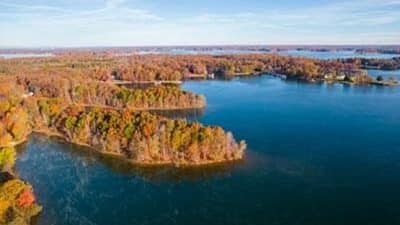
Funded by the USDA Forest Service’s Southern Region, the GIC and VDOF assisted coastal counties and cities with mapping their coastal forests, modeling benefits and evaluating threats they face along with strategies to mitigate or reverse impacts.
The study looks at threats facing forests in an area that includes six of Virginia’s coastal counties, six towns and two cities. Urban, suburban and rural trees and forests are susceptible to climate damage and were modeled alike. Threats examined include large wildfires, climate change, storms, pests and disease, and land conversion to development or utility-scale solar.
Results found that of the 237,501 acres of coastal forestland in the study area, more than half are at risk from three or more threats. This, along with the rest of the findings, shows Virginians what is at stake and what could be lost.
Findings take a particularly close look at the impacts on forests when two or more threats are present at the same time. A healthy forest can often withstand the effects of any one threat, but when two or more are present, this changes. For example, when southern pine beetles infest a forest that has already been stressed by salt damage, many trees in the affected area die.
According to GIC’s community forester Matt Lee, “Losses to these forests impact landowners’ investments in trees grown for lumber. We also see more impacts on people and property as we lose the trees that buffer us against storms.”
Within the study area, 127,939 acres (54 percent) of coastal forests are at moderate to high risk from three or more threats. For example, more than 21,000 acres of forests within the study are at high risk from wildfire. While wildfire is a natural event, stressed forests that are weakened by pests or salt are more susceptible to wildfire, allowing fires to burn stronger and cause far more damage, permanently killing trees in some cases. Rising water levels have further exacerbated this by causing a proliferation of the invasive phragmites grass, a potent wildfire fuel source. “When development expands into these areas, conditions can come together in a ‘perfect storm’ wildfire event that can quickly threaten lives and property,” said VDOF senior area forester, Robbie Lewis.
On the other hand, Virginia’s coastal forests are providing crucial benefits. The study found that forests within the study area are capturing nearly 800,000 tons of carbon annually while storing more than 32 million tons – a key strategy for slowing climate change. They are also capturing 2.5 billion gallons of stormwater for every 2-inch rainfall event while supporting 330 species of terrestrial vertebrates, 10 federally or state-listed threatened or endangered species, and providing more than $10 million worth of wood products. These are just some of the many benefits coastal forests provide.
State and local entities and agencies are already working together to develop and implement strategies to address these threats. For example, VDOF is undertaking work to help restore native longleaf pine forests and is replanting live oak trees grown from their nurseries along the coast. Local governments such as Gloucester County have begun to limit the acreage of rural lands that can be developed into large-scale solar facilities, ensuring that the impacts on forests are lessened as development expands.
This is important when considering how to combat climate change. “It’s up to communities to decide whether the benefits of utility-scale solar installations are greater than the forests which are actively sequestering carbon, improving air and water quality, and protecting Virginia’s coasts,” said GIC director Karen Firehock. To learn more about this study, the benefits coastal forests provide, the threats they are facing and actions we can take, visit GIC’s website.










